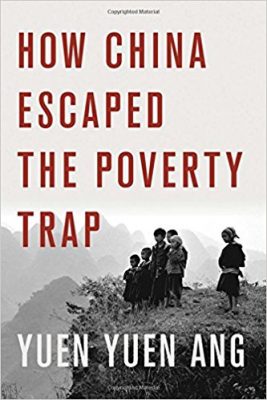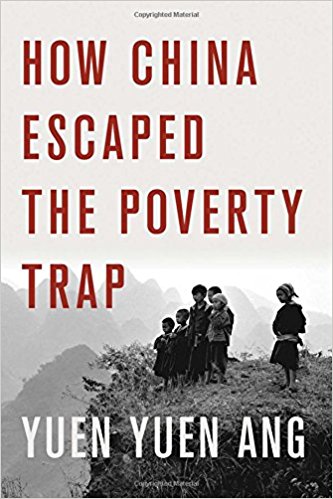 Author: Yuen Yuen Ang
Author: Yuen Yuen Ang
Publisher: Cornell University Press – 326 pages
Book Review by: Sonu Chandiram
As of today, April 9, 2017, China has 1.387 billion people, according to the population-tracking website www.worldometers.info. India has 1.339 billion, and No.3 in population is the United States with nearly 326 million people. The total world population consists of 7.497 billion people. China’s share is 18.50 percent; India’s is 17.86 percent, and the United States’ share is 4.35 percent, for a total of 30.5 billion people, or nearly 41 percent of all people on the planet.
China, now the world’s second largest economy, had a gross domestic product of $11.392 trillion at the end of 2016, which comprised about 61 percent of the Unite States’ GDP of $18.562 trillion. India’s GDP was $2.251 trillion, about 12 percent of the U.S. economy. These three GDP numbers from the International Monetary Fund (aka World Bank) total up to $32.2 trillion, which together comprise nearly 42 percent of world’s economy of $75.212 trillion.
You will note a huge, glaring disparity in the figures above: while China and India have almost the same number of inhabitants (India having about 97 percent as many people as China) India’s economy is much, much smaller. Of the total $32.2 trillion output among the world’s three most populous nations India’s $2.25 trillion is a measly, less than seven percent of the total.
So it is somewhat expected that the average Indian earned a mere $1,604 a year, which is less than one-fifth of the average Chinese who earned $8,141 in 2016. Similarly, India’s total GDP was just shy of 20 percent of China’s in 2016, just about the same as each individual’s share of the country’s economic output.
This book provides answers to why China escaped the poverty trap. India, with about the same number of people, fell into that trap and is still deeply mired in it. It is granted that both these countries have their shares of billionaires and millionaires, so why should the average Indian make just twenty cents for every dollar that the typical Chinese makes?
Yuen Yuen Ang answers the question of why China escaped the poverty trap by looking at the relationship between effective governance and economic growth. While the answer on the surface is that China had (and continues to have) an effective government permeating all levels of bureaucracy from the very top to the very bottom, the author Ms. Ang delves into the nuances and details of such governance, through the following six chapters of this highly insightful book:
Introduction How Did Development Actually Happen?
- Part I. Framework and Building Blocks
- Mapping Co-evolution
- Directed Improvisation
- Part II. Direction
- Balancing Variety and Uniformity
- Franchising the Bureaucracy
- Part III. Improvisation
- From Building to Preserving Markets
- Connecting First Movers and Laggards
Conclusion: How Development Actually Happened Beyond China
She starts out by asking: which comes first in development – economic growth, or good governance? And she provides the answer in detail.
One of the most important reasons why China’s economic growth got on to a face pace is that both the government and the governed adapted to each other quite rapidly, and it seems almost as though they stepped ahead in tandem. Ms. Ang terms this as ‘co-evolution’ and discusses it at length in the first chapter.
During the Maoist era (1949-1976) China’s economy was state-owned and state-controlled and was for the most part in a state of stagnation. After that, economic reformists led by Deng Xiaoping came into power. He introduced and emphasized market principles that began in 1978.
Dramatic changes happened: among them were the collectivization of agriculture, opening up the country to foreign investment, allowing entrepreneurs to start businesses, and very importantly, privatization, including contracting out of state-owned industry, and lifting of price controls, protectionist policies, and regulations.
This book has a solid empirical foundation: it is based not just on concepts and theories but on a lot of fieldwork, including interviews of about three hundred people by the author. She typically asked each local government person she met, this question:
“In your locality, do you think it was effective governance that led to growth or growth that enabled the government to improve? The bureaucrats were consistently astonished by the naivete of the question. To them, the answer is obvious: causation runs both ways. One regular cadre in a city-level agency, who had no scholarly training whatsoever, gave a memorably insightful reply:
The economy and the bureaucracy interact and change together. If the economy is poor, then inevitably, it will be difficult to improve governance…in reality, we do what we see and then adjust as we go along…there must be a process. It’s impossible for a government to reform overnight.”
This is an excellent work on the causes of China’s astonishing transformation from a painfully slow, bureaucratic-bound, state-controlled country to its rapid development to become the world’s second-largest economy. Much can be learned from this valuable book by people in different sectors of society.
Author:
Yuen Yuen Ang is an Assistant Professor of Political Science at the University of Michigan. She is a winner of the 2014 GDN Next Horizons Essay Award on “The Future of Development Assistance” sponsored by the Bill and Melinda Gates Foundation.







